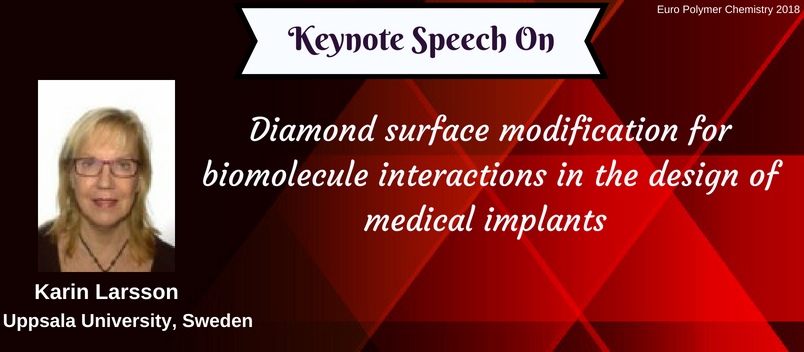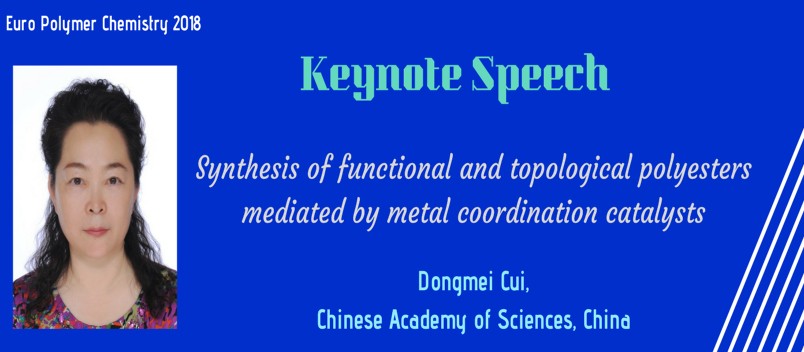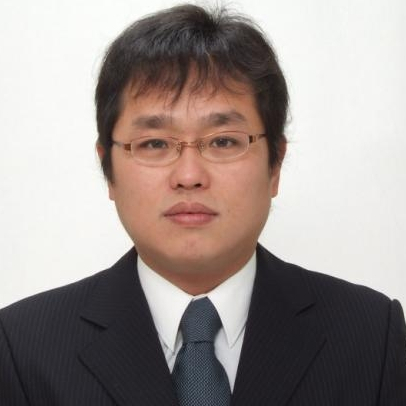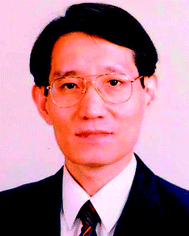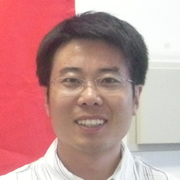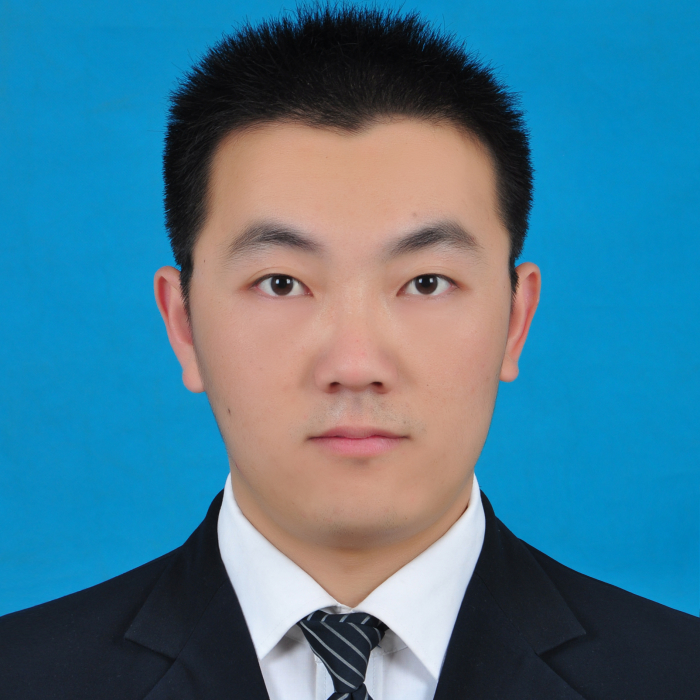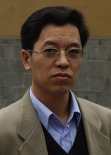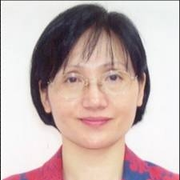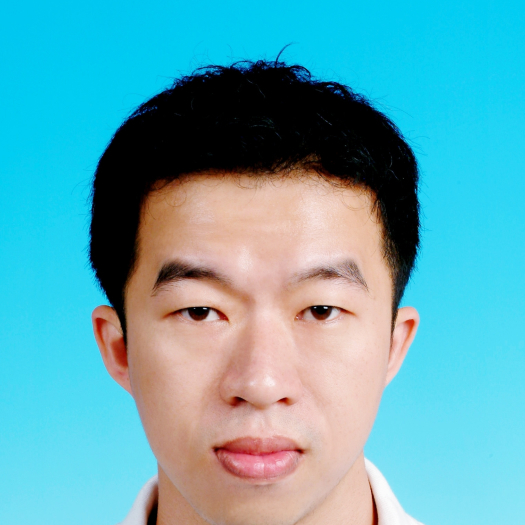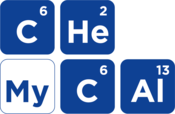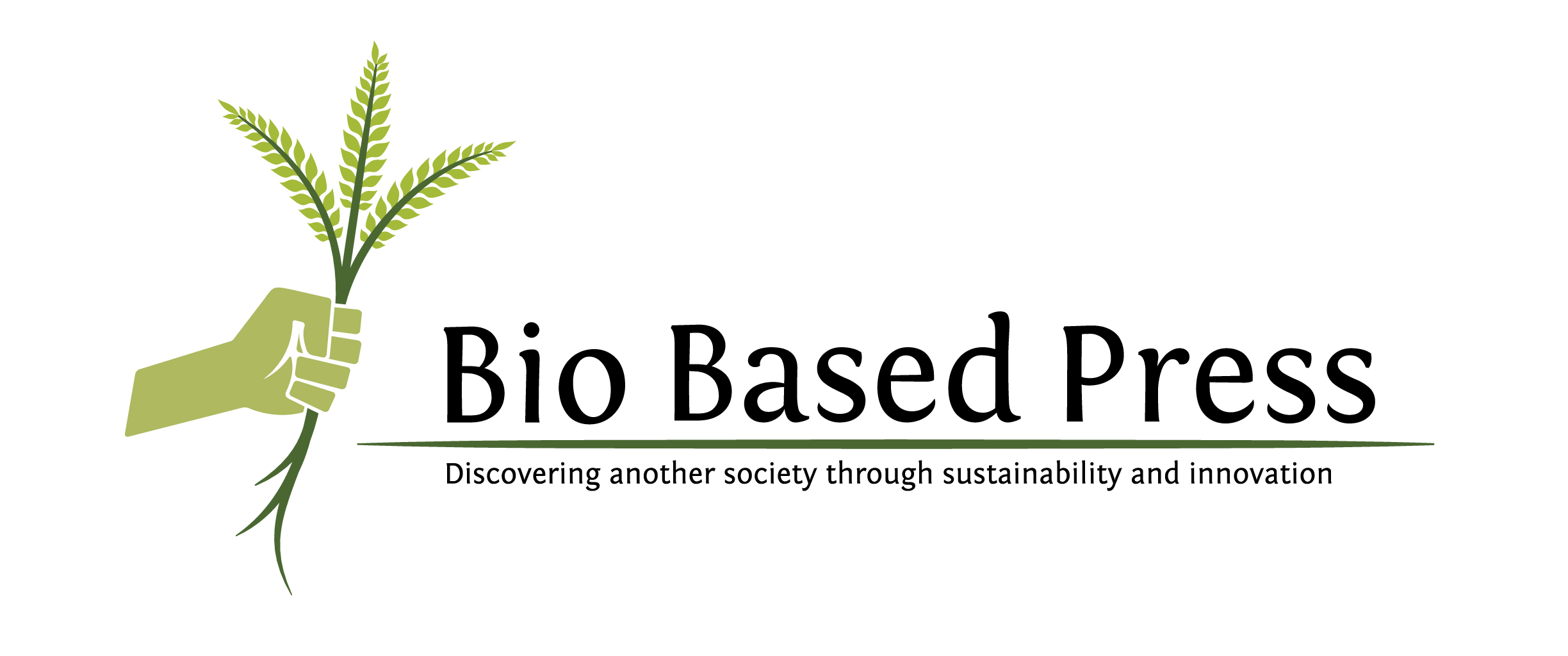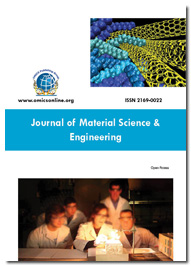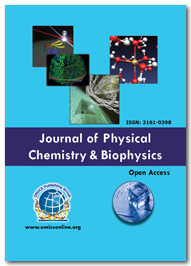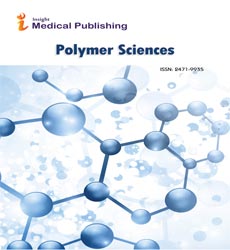Theme: Polymer Chemistry: Creating Big Ideas in Science
Euro Polymer Chemistry 2018
Conference Series Ltd invites all the participants from all over the world to attend “4th International Conference and Exhibition on Polymer Chemistry’’ during June 25-27, 2018 Stockholm, Sweden which includes prompt keynote presentations, Oral talks, Poster presentations and Exhibitions.
While much research and product development in industry is product oriented, it requires scientists with a grasp of the foundations of chemistry, creativity, the ability to work together, and enjoy seeing the practical challenges encountered and solutions adopted in the fields of Polymer Chemistry. Polymer Chemistry 2018 covers all the aspects of related field researchers, The forum of Scientists, and students from all corners of the globe, come together to discuss about polymer science and its advances. It also provides a premier interdisciplinary platform for researchers, practitioners and educators to present and discuss the most recent innovations and trends.
Why to attend our Conference
It promotes the positive contributions of Polymers/plastics by
·Highlighting the material’s beneficial properties and its positive contributions to society throughout its life cycle
·Providing society with educational information to help raise awareness and correct misconceptions
This experience helps the Conference to be an interactive forum and encourages a strong level of dialogue and discussion, thus maximizing the benefits of attendance. Each session of the meeting will be included with expert lectures, poster and discussions, join us to design sustainable development processes, advances the business and sustainability in drug production for further health care protection of lives. We are glad to invite you on behalf of organizing committee to join us, where you are the decision maker for future.
Target Audience for Polymer Chemistry 2018:
Eminent Scientists/ Research Professors in the field of polymer chemistry, Junior/Senior research fellows, Students, Directors of polymer research companies, Chemical Engineers, Members of different physics and Chemistry associations.
Track 1:- Recent Developments in Polymer Synthesis
Polymers occupy a major place and pivotal position in our materials map today. In application prospects and performance characteristics and in property range and diversity, they offer novelty and versatility that can hardly be matched by any other kind of materials. Polymer chemistry is combining several specialized fields of expertise. It deals not only with the chemical synthesis but Polymer Structures and chemical properties of polymers and polymer bio conjugation, Novel synthetic and polymerization methods. Polymer synthesis is a complex procedure and can take place in a variety of ways. Polymers are long chain; giant organic molecules are assembled from many smaller molecules called monomers. Polymers consist of many repeating monomer units in long chains, sometimes with branching or cross-linking between the chains. A chemical reaction forming polymers from monomers is called polymerization, of which there are many types. Polymers have come to play an essential and ubiquitous role in everyday life - from plastics and elastomers on the one hand to natural biopolymers such as DNA and proteins on the other hand.
Related Conferences: Polymer Chemistry Conferences | Polymer Science and Engineering| Polymer Congress | Polymer Conferences.
10th International Conference on Chemistry Education, May 21-22, 2018 Oslo, Norway; 9th Global Chemistry Congress, July 23-24, 2018 Lisbon, Portugal; 8th World Congress on Chromatography, September 13-14, 2018 Prague, Czech Republic; 9th World Congress on Green Chemistry and Technology, September 17-19, 2018 Amsterdam, Netherlands; 5th International Conference on Organic and Inorganic Chemistry, July 12-13, 2018 Paris, France; International Conference on Polymers and Organic Chemistry 2018 (POC 2018) 04 - 07 June 2018, Montpellier, France; 8th International Conference on Environmental Chemistry and Engineering, September 20-22, 2018, Berlin, Germany; 9th International Conference and Expo on Separation Techniques, September 13-14, 2018 , Zurich, Switzerland.
Related Societies:- European Polymer Federation Congress , Swedish Chemical Society, Czech Chemical Society, Australian-European Polymer Symposium , Royal Netherlands Chemical Society (KNCV), Hungarian Society for Separation Science , Federation of Asian Chemical Societies, Polymer Society of Korea , Portuguese Chemical Society , Chemical Industries Association, Chromatographic Society of India.
Track 2:- Advanced Polymer Characterization
Polymer characterization is the analytical branch of polymer science. The discipline is concerned with the characterization of polymeric materials on a variety of levels. Characterization of polymers is important for synthesis of new materials or at the time of evaluation of competitive product. The characterization typically has as a goal to improve the performance of a product. Polymer Characterization includes determining molecular weight distribution, the molecular structure, the morphology of the polymer, thermal properties, mechanical and optical properties, and any additives. Many characterization techniques should ideally be linked to these desirable properties of the material. It also includes the development and refinement of analytical methods with statistical models which help to understand phase separation and phase transistion of polymers. It is a complex and multi-faceted process.
Related Conferences: : Polymer Chemistry Conferences | Polymer Science and Engineering| Polymer Congress | Polymer Conferences.
9th International Conference and Expo on Separation Techniques, September 13-14, 2018, Zurich, Switzerland; 10th International Conference on Chemistry Education, May 21-22, 2018 Oslo, Norway; 9th Global Chemistry Congress, July 23-24, 2018 Lisbon, Portugal; 8th World Congress on Chromatography, September 13-14, 2018 Prague, Czech Republic; 9th World Congress on Green Chemistry and Technology, September 17-19, 2018 Amsterdam, Netherlands; International Conference on Polymers and Organic Chemistry 2018 (POC 2018) 04 - 07 June 2018, Montpellier, France; 8th International Conference on Environmental Chemistry and Engineering, September 20-22, 2018, Berlin, Germany; 5th International Conference on Organic and Inorganic Chemistry, July 12-13, 2018 Paris, France.
Related Societies:- Portuguese Chemical Society , European Polymer Federation Congress, Swedish Chemical Society, Czech Chemical Society, Australian-European Polymer Symposium , Royal Netherlands Chemical Society (KNCV), Hungarian Society for Separation Science , Federation of Asian Chemical Societies, Polymer Society of Korea , Chemical Industries Association, Chromatographic Society of India.
Track 3:- Biopolymers
Biopolymers are polymers that bio-debase with the activity of smaller scale life forms, warmth, and dampness. There is no particular standard for biodegradation. This session contents the biopolymers types and application and trends in different field. It provides an up-to-date summary of the varying market applications of biopolymers characterized by biodegradability and sustainability. Biopolymers can be made utilizing waste starch from a harvest that has been developed for sustenance utilize. Biopolymers are polymers that are biodegradable. The input materials for the production of these polymers may be either renewable (based on agricultural plant or animal products) or synthetic. Increased use of biopolymers would replace fossil fuels thus helping in sustainable development. This Session Include the Chemistry of biopolymers, Polylactic acid in Biopolymers, Nucleic acids in Biopolymers, Polysaccharides in Biopolymers, Polynucleotide in Biopolymers.
Related Conferences: Polymer Chemistry Conferences | Polymer Science and Engineering| Polymer Congress | Polymer Conferences.
9th World Congress on Green Chemistry and Technology, September 17-19, 2018 Amsterdam, Netherlands; 9th International Conference and Expo on Separation Techniques, September 13-14, 2018 Zurich, Switzerland; 8th World Congress on Chromatography, September 13-14, 2018 Prague, Czech Republic; 10th International Conference on Chemistry Education, May 21-22, 2018 Oslo, Norway; 9th Global Chemistry Congress, July 23-24, 2018 Lisbon, Portugal; International Conference on Polymers and Organic Chemistry 2018 (POC 2018) 04 - 07 June 2018, Montpellier, France; 8th International Conference on Environmental Chemistry and Engineering, September 20-22, 2018, Berlin, Germany; 5th International Conference on Organic and Inorganic Chemistry, July 12-13, 2018 Paris, France.
Related Societies:- Royal Netherlands Chemical Society (KNCV), Portuguese Chemical Society , European Polymer Federation Congress, Swedish Chemical Society, Czech Chemical Society, Australian-European Polymer Symposium , Hungarian Society for Separation Science , Federation of Asian Chemical Societies, Polymer Society of Korea , Chemical Industries Association, Chromatographic Society of India.
Track 4:- Polymer engineering and technology
Polymer engineering and technology is part of the growing field of materials engineering that focuses on plastics and other polymers. A Polymer Material Sciences will provide you with a strong basis in the wide range of issues around structure- functional relationship of polymers. Polymer Engineering is generally an engineering field that designs, analyses, and/or modifies polymer materials. The prediction of their behavior depends on our understanding of these complex systems. Polymerization and polymer processing techniques thus requires molecular modeling techniques. Beside metals and ceramics, the recent developments of Polymer Technology have revolutionized the field of material science increasing the use of polymer based substances from building materials to Packing materials, Fancy decoration articles, Communications, Automobile, Aircrafts, etc. She has been able to tailor the industry needs to suit the specifications provided. Synthetic polymers have since a long time played a relatively important role in present-day medicinal practice. Polymers are now a major materials used in many industrial applications.
Related Conferences: Polymer Chemistry Conferences | Polymer Science and Engineering| Polymer Congress | Polymer Conferences.
8th International Conference on Environmental Chemistry and Engineering, September 20-22, 2018, Berlin, Germany; 9th World Congress on Green Chemistry and Technology, September 17-19, 2018 Amsterdam, Netherlands; 9th International Conference and Expo on Separation Techniques, September 13-14, 2018 Zurich, Switzerland; 8th World Congress on Chromatography, September 13-14, 2018 Prague, Czech Republic; 10th International Conference on Chemistry Education, May 21-22, 2018 Oslo, Norway; 9th Global Chemistry Congress, July 23-24, 2018 Lisbon, Portugal; International Conference on Polymers and Organic Chemistry 2018 (POC 2018) 04 - 07 June 2018, Montpellier, France; 5th International Conference on Organic and Inorganic Chemistry, July 12-13, 2018 Paris, France.
Related Societies:- Hungarian Society for Separation Science , Royal Netherlands Chemical Society (KNCV), Australian-European Polymer Symposium , Portuguese Chemical Society , European Polymer Federation Congress, Swedish Chemical Society, Czech Chemical Society, Federation of Asian Chemical Societies, Polymer Society of Korea , Chemical Industries Association, Chromatographic Society of India.
Track 5:- Supramolecular polymers
After more than two decades of history, the field of supramolecular polymers remains one of the most active in polymer science. This is certainly due to the wide interest that supramolecular polymers raise from both a fundamental and applied perspective, which in recent years has brought a deep understanding of their physicochemical properties and advanced functionalities.
The session will feature a wide range of topical discussions, highlighting important fields such as Nano machines, meso-scale self-assembly, controlled supramolecular polymerization, and 2-D and 3-D coordination frameworks. A particular focus will be given to the complexity in self-assembly processes and how it can result in novel functions. As such, a wide variety of different applications ranging from biomedical engineering and the life sciences to energy and food science and device fabrication will be addressed.
Related Conferences: Polymer Chemistry Conferences | Polymer Science and Engineering| Polymer Congress | Polymer Conferences.
5th International Conference on Organic and Inorganic Chemistry, July 12-13, 2018 Paris, France ; 8th International Conference on Environmental Chemistry and Engineering, September 20-22, 2018, Berlin, Germany; 9th World Congress on Green Chemistry and Technology, September 17-19, 2018 Amsterdam, Netherlands; 9th International Conference and Expo on Separation Techniques, September 13-14, 2018 Zurich, Switzerland; 8th World Congress on Chromatography, September 13-14, 2018 Prague, Czech Republic; 9th Global Chemistry Congress, July 23-24, 2018 Lisbon, Portugal; International Conference on Polymers and Organic Chemistry 2018 (POC 2018) 04 - 07 June 2018, Montpellier, France; 10th International Conference on Chemistry Education, May 21-22, 2018 Oslo, Norway.
Related Societies:- Swedish Chemical Society, Czech Chemical Society, Hungarian Society for Separation Science, Royal Netherlands Chemical Society (KNCV), Australian-European Polymer Symposium , Portuguese Chemical Society , Federation of Asian Chemical Societies, Polymer Society of Korea , Chemical Industries Association, Chromatographic Society of India, European Polymer Federation Congress.
Track 6:-Bioplastics
Bioplastics are one of the driving tool in the advancement of plastics. Bio plastics are plastics derived from renewable biomass sources, such as vegetable fats and oils, from used plastic bottles and other containers using microorganisms rather than petroleum. Bioplastics are fossil savior and gives additional recovery at the end by degradation.as Petro based polymers produce more greenhouse gases. Some, but not all, bioplastics are designed to biodegrade. Many bioplastics are biodegradable, which is - in theory - one of their greatest advantages. They may or may not be biodegradable depending on how they are manufactured. Biodegradable bioplastics can break down in either anaerobic or aerobic environments. Bioplastics can be composed of starches, cellulose, biopolymers, and a variety of other materials.
Related Conferences: Polymer Chemistry Conferences | Polymer Science and Engineering| Polymer Congress | Polymer Conferences.
5th International Conference on Organic and Inorganic Chemistry, July 12-13, 2018 Paris, France ; 8th International Conference on Environmental Chemistry and Engineering, September 20-22, 2018, Berlin, Germany; 9th World Congress on Green Chemistry and Technology, September 17-19, 2018 Amsterdam, Netherlands; 8th World Congress on Chromatography, September 13-14, 2018 Prague, Czech Republic; 9th Global Chemistry Congress, July 23-24, 2018 Lisbon, Portugal; 9th International Conference and Expo on Separation Techniques, September 13-14, 2018 Zurich, Switzerland; International Conference on Polymers and Organic Chemistry 2018 (POC 2018) 04 - 07 June 2018, Montpellier, France; 10th International Conference on Chemistry Education, May 21-22, 2018 Oslo, Norway.
Related Societies:- Polymer Society of Korea , Chemical Industries Association, Swedish Chemical Society, Czech Chemical Society, Hungarian Society for Separation Science, Royal Netherlands Chemical Society (KNCV), Australian-European Polymer Symposium , Portuguese Chemical Society , Federation of Asian Chemical Societies, Chromatographic Society of India, European Polymer Federation Congress.
Track 7:- Polymer Blends
A polymer blend or polymer mixture is a member in which at least two polymers are blended together to create a new material with different physical properties. Polymer blends are physical mixtures of two or more polymers with/without any chemical bonding between them. The objective of polymer blending is a practical one of achieving commercially viable products through either unique properties or lower cost than some other means might provide. Blending technology also provides attractive opportunities for reuse and recycling of polymer wastes. When two or more polymers are mixed, the phase structure of the resulting material can be either miscible or immiscible. Due to their high molar mass, the entropy of mixing of polymers is relatively low and consequently specific interactions are needed to obtain blends, which are miscible or homogeneous on a molecular scale. This session will include discussion on thermodynamics and compatibilisation of polymer blends and its applications. Compatibilisation is very useful for improving the dispersity in polymer blends. Additionally, medical polymers may be blended with specialized additives for enhanced properties to achieve specific functional requirements.
Related Conferences: Polymer Chemistry Conferences | Polymer Science and Engineering| Polymer Congress | Polymer Conferences.
International Conference on Polymers and Organic Chemistry 2018 (POC 2018) 04 - 07 June 2018, Montpellier, France; 5th International Conference on Organic and Inorganic Chemistry, July 12-13, 2018 Paris, France ; 8th International Conference on Environmental Chemistry and Engineering, September 20-22, 2018, Berlin, Germany; 9th World Congress on Green Chemistry and Technology, September 17-19, 2018 Amsterdam, Netherlands; 8th World Congress on Chromatography, September 13-14, 2018 Prague, Czech Republic; 9th Global Chemistry Congress, July 23-24, 2018 Lisbon, Portugal; 9th International Conference and Expo on Separation Techniques, September 13-14, 2018 Zurich, Switzerland; 10th International Conference on Chemistry Education, May 21-22, 2018 Oslo, Norway.
Related Societies:- Portuguese Chemical Society , Federation of Asian Chemical Societies, Polymer Society of Korea , Chemical Industries Association, Swedish Chemical Society, Czech Chemical Society, Hungarian Society for Separation Science, Royal Netherlands Chemical Society (KNCV), Australian-European Polymer Symposium , Chromatographic Society of India, European Polymer Federation Congress.
Track 8:- Biodegradable polymers
Biodegradable polymers are defined as Polymers comprised of monomers linked to one another through functional groups and have unstable links in the backbone. They are broken down into biologically acceptable molecules that are metabolized and removed from the body via normal metabolic pathways. This session presents the product made from natural fiber reinforce biodegradable polymer composites are yet to be seen in high magnitude. The development of biodegradable polymer composites promotes the use of environmentally friendly materials. Most in the industry use the term bioplastic to mean a plastic produced from a biological source. All (bio- and petroleum-based) plastics are technically biodegradable, meaning they can be degraded by microbes under suitable conditions. Biodegradable Polymers can also use to control the drug release rate from the formulations. The applications of polymers in drug delivery have been realized because polymers offer unique properties which so far have not been attained by any other materials. Current and future developments in biodegradable polymers and renewable input materials focus relate mainly to the scaling-up of production and improvement of product properties. Larger scale production will increase availability and reduce prices. It is often necessary to seek a compromise between the desired material properties and biodegradability.
Related Conferences: Polymer Chemistry Conferences | Polymer Science and Engineering| Polymer Congress | Polymer Conferences.
9th Global Chemistry Congress, July 23-24, 2018 Lisbon, Portugal; International Conference on Polymers and Organic Chemistry 2018 (POC 2018) 04 - 07 June 2018, Montpellier, France; 5th International Conference on Organic and Inorganic Chemistry, July 12-13, 2018 Paris, France ; 8th International Conference on Environmental Chemistry and Engineering, September 20-22, 2018, Berlin, Germany; 9th World Congress on Green Chemistry and Technology, September 17-19, 2018 Amsterdam, Netherlands; 8th World Congress on Chromatography, September 13-14, 2018 Prague, Czech Republic; 9th International Conference and Expo on Separation Techniques, September 13-14, 2018 Zurich, Switzerland; 10th International Conference on Chemistry Education, May 21-22, 2018 Oslo, Norway.
Related Societies:- Royal Netherlands Chemical Society (KNCV), Portuguese Chemical Society, Federation of Asian Chemical Societies, Polymer Society of Korea , Chemical Industries Association, Swedish Chemical Society, Czech Chemical Society, Hungarian Society for Separation Science, Australian-European Polymer Symposium , Chromatographic Society of India, European Polymer Federation Congress.
Track 9:- Polymer and Microfluidics
Microfluidics is both the science which studies the behavior of fluids through micro-channels, and the technology of manufacturing microminiaturized devices. Several material properties of glass helps for use in microfluidic systems; however, the cost of producing systems in glass is very high and this driving commercial producers to look for cost effective materials. At Commercial level, manufacturers found it beneficial to use plastics that include reduced cost and simplified manufacturing procedures. An additional benefit that is extremely attractive is the wide range of available plastic materials which allows the manufacturer to choose materials' based on its properties for particular application. This session will discuss role of polymers in microfluidic systems including their material properties, fabrication methods, device applications, and finally market analysis and future developments .Nowadays, advanced micro fabrication techniques enable the creation of complex, integrated microfluidic chips, which perform multiple analytic investigations on the same chip. This new technique is used in the fields of analysis in medical and forensic science.
Related Conferences: Polymer Chemistry Conferences | Polymer Science and Engineering| Polymer Congress | Polymer Conferences.
10th International Conference on Chemistry Education, May 21-22, 2018 Oslo, Norway; 9th Global Chemistry Congress, July 23-24, 2018 Lisbon, Portugal; International Conference on Polymers and Organic Chemistry 2018 (POC 2018) 04 - 07 June 2018, Montpellier, France; 5th International Conference on Organic and Inorganic Chemistry, July 12-13, 2018 Paris, France ; 8th International Conference on Environmental Chemistry and Engineering, September 20-22, 2018, Berlin, Germany; 9th World Congress on Green Chemistry and Technology, September 17-19, 2018 Amsterdam, Netherlands; 8th World Congress on Chromatography, September 13-14, 2018 Prague, Czech Republic; 9th International Conference and Expo on Separation Techniques, September 13-14, 2018 Zurich, Switzerland.
Related Societies:- Royal Netherlands Chemical Society (KNCV), Portuguese Chemical Society, Federation of Asian Chemical Societies, Polymer Society of Korea , Chemical Industries Association, Swedish Chemical Society, Czech Chemical Society, Hungarian Society for Separation Science, Australian-European Polymer Symposium , Chromatographic Society of India, European Polymer Federation Congress.
Track 10:- Functional Polymers and its Applications
Functional polymers are macromolecules to which chemically bound functional groups are attached which can be utilized as reagents, catalysts, protecting groups, etc. Functional polymers have low cost, ease to process and a range of attractive mechanical characteristics for functional organic molecules. This session deals with the synthesis and design of functional polymers, modifications of preformed polymer backbones as well as its various applications. The polymer support can be either a linear species which is soluble or a cross-linked species which is insoluble. A polymer to be used as a support should have significant mechanical stability under the reaction conditions. Such properties of the support play important role in functionalization reactions of polymers .The polymer properties can be modified either by chemical reactions on pendant groups or by changing the physical nature of the polymers.
Related Conferences: Polymer Chemistry Conferences | Polymer Science and Engineering| Polymer Congress | Polymer Conferences.
10th International Conference on Chemistry Education, May 21-22, 2018 Oslo, Norway; 9th Global Chemistry Congress, July 23-24, 2018 Lisbon, Portugal; 5th International Conference on Organic and Inorganic Chemistry, July 12-13, 2018 Paris, France ; 8th International Conference on Environmental Chemistry and Engineering, September 20-22, 2018, Berlin, Germany; 9th World Congress on Green Chemistry and Technology, September 17-19, 2018 Amsterdam, Netherlands; International Conference on Polymers and Organic Chemistry 2018 (POC 2018) 04 - 07 June 2018, Montpellier, France; 8th World Congress on Chromatography, September 13-14, 2018 Prague, Czech Republic; 9th International Conference and Expo on Separation Techniques, September 13-14, 2018 Zurich, Switzerland.
Related Societies:- Federation of Asian Chemical Societies, Polymer Society of Korea , Royal Netherlands Chemical Society (KNCV), Portuguese Chemical Society, Chemical Industries Association, Swedish Chemical Society, Czech Chemical Society, Hungarian Society for Separation Science, Australian-European Polymer Symposium , Chromatographic Society of India, European Polymer Federation Congress.
Track 11:- Nanopolymers and Nanotechnology
Nanotechnology is one of the trending areas for current research and development in basically all technical disciplines. Nanotechnology is science, engineering of functional systems at the molecular scale and technology conducted at the Nano scale, which is about 1 to 100 nanometers This obviously includes Polymer Nanotechnology which include microelectronics, polymer-based biomaterials, Nano medicine, Nano emulsion particles; polymer bound catalysts, electro spun nanofabrication, imprint lithography, and block copolymer domain morphology is usually at the Nano scale level. The transition from micro- to nano-particles lead to change in its physical as well as chemical properties. Increase in the ratio of the surface area to volume and the size of the particle are the key factors in this. Nano composites have become a prominent area of current research and development. Polymer Nano composites (PNC) consist of a polymer or copolymer having nanoparticles or nanofillers dispersed in the polymer matrix. These may be of different shape (e.g., platelets, fibers, spheroids), but at least one dimension must be in the range of 1–50 nm. Important extensions have been made in combining inorganic materials with polymers and in combining different classes of polymers together in nanoparticle form.
Related Conferences: Polymer Chemistry Conferences | Polymer Science and Engineering| Polymer Congress | Polymer Conferences.
9th International Conference and Expo on Separation Techniques, September 13-14, 2018 Zurich, Switzerland ; 10th International Conference on Chemistry Education, May 21-22, 2018 Oslo, Norway; 9th Global Chemistry Congress, July 23-24, 2018 Lisbon, Portugal; 5th International Conference on Organic and Inorganic Chemistry, July 12-13, 2018 Paris, France ; 8th International Conference on Environmental Chemistry and Engineering, September 20-22, 2018, Berlin, Germany; 9th World Congress on Green Chemistry and Technology, September 17-19, 2018 Amsterdam, Netherlands; International Conference on Polymers and Organic Chemistry 2018 (POC 2018) 04 - 07 June 2018, Montpellier, France; 8th World Congress on Chromatography, September 13-14, 2018 Prague, Czech Republic;.
Related Societies:- Czech Chemical Society, Hungarian Society for Separation Science, Federation of Asian Chemical Societies, Polymer Society of Korea , Royal Netherlands Chemical Society (KNCV), Portuguese Chemical Society, Chemical Industries Association, Swedish Chemical Society, Australian-European Polymer Symposium , Chromatographic Society of India, European Polymer Federation Congress.
Track 12:- Polymer Electronics and Optics
Polymers are normally electrical insulators, but to enable their use in electronics, conductive filler such as silver have been added to chemical formulation to increase their electrical conductivity. This is because polymers are good insulator of heat, have low density , require low finishing cost and its enhanced flexibility allowed for many application. Polymer electronics is an emerging technology that focuses on the development of electronic devices incorporating electrically conductive and semi conductive organic materials, especially organic polymers. It offers the prospect of an advanced electronics platform using new materials, processes and electronic devices. Polymer conductors and semiconductors open up propects for microelectronic systems that go beyond the scope of conventional electronics based on silicon as the semiconductor. The deposition of a range of polymer electronic devices by simple techniques such as printing is likely to extend the realm of electronics. The latest research in the field of polymer optical components includes development of microoptics injection molding coating technology and assembly technologies. Microwave-Enhanced Polymer Chemistry and Technology describes novel approaches to polymer processing using microwave technologies.
Related Conferences: Polymer Chemistry Conferences | Polymer Science and Engineering| Polymer Congress | Polymer Conferences.
9th International Conference and Expo on Separation Techniques, September 13-14, 2018 Zurich, Switzerland ; 10th International Conference on Chemistry Education, May 21-22, 2018 Oslo, Norway; 9th Global Chemistry Congress, July 23-24, 2018 Lisbon, Portugal; 5th International Conference on Organic and Inorganic Chemistry, July 12-13, 2018 Paris, France ; 8th International Conference on Environmental Chemistry and Engineering, September 20-22, 2018, Berlin, Germany; 9th World Congress on Green Chemistry and Technology, September 17-19, 2018 Amsterdam, Netherlands; International Conference on Polymers and Organic Chemistry 2018 (POC 2018) 04 - 07 June 2018, Montpellier, France; 8th World Congress on Chromatography, September 13-14, 2018 Prague, Czech Republic.
Related Societies:- Portuguese Chemical Society, Chemical Industries Association, Swedish Chemical Society, Australian-European Polymer Symposium , Chromatographic Society of India, European Polymer Federation Congress, Czech Chemical Society, Hungarian Society for Separation Science, Federation of Asian Chemical Societies, Polymer Society of Korea , Royal Netherlands Chemical Society (KNCV).
Track 13:- Application of polymers
Polymers are a highly diverse class of materials which are available in all fields of engineering from avionics through drug delivery system, bio-sensor devices, Holography, 3D printing, tissue engineering, cosmetics etc. and the improvement and usage of these depends on polymer applications .The applications of polymeric materials and their composites are still increasing rapidly due to their below average cost and ease of manufacture. This in turn fuels further development in research.
Research and development of bioplastics substances for medical, dental and pharmaceutical use have hovered on the front lines for years. Gelatin-based capsules made of animal or vegetable matter, for example, which naturally dissolve in the digestive tract, are in common use. Biodegradable stitches, which do not require manual removal after healing, are regularly used to suture wounds and surgical incisions.
Biopolymers are available as coatings for paper rather than the more common petrochemical coatings. Bioplastics are used for disposable items, such as packaging and crockery. They are also often used for bags, trays, fruit and vegetable containers and in marine sciences .These plastics are also used in non-disposable applications including mobile phone casings, carpet fibers, insulation car interiors, fuel lines, and plastic piping. New electroactive bioplastics are being developed that can be used to carry electric current. Medical implants made of PLA (polylactic acid), which dissolve in the body, can save patients a second operation. Compostable mulch films can also be produced from starch polymers and used in agriculture.
Related Conferences: Polymer Chemistry Conferences | Polymer Science and Engineering| Polymer Congress | Polymer Conferences.
International Conference on Polymers and Organic Chemistry 2018 (POC 2018) 04 - 07 June 2018, Montpellier, France; 9th International Conference and Expo on Separation Techniques, September 13-14, 2018 Zurich, Switzerland ; 10th International Conference on Chemistry Education, May 21-22, 2018 Oslo, Norway; 9th Global Chemistry Congress, July 23-24, 2018 Lisbon, Portugal; 5th International Conference on Organic and Inorganic Chemistry, July 12-13, 2018 Paris, France ; 8th International Conference on Environmental Chemistry and Engineering, September 20-22, 2018, Berlin, Germany; 9th World Congress on Green Chemistry and Technology, September 17-19, 2018 Amsterdam, Netherlands; 8th World Congress on Chromatography, September 13-14, 2018 Prague, Czech Republic.
Related Societies:- Portuguese Chemical Society, Chemical Industries Association, Swedish Chemical Society, Australian-European Polymer Symposium , Chromatographic Society of India, European Polymer Federation Congress, Czech Chemical Society, Hungarian Society for Separation Science, Federation of Asian Chemical Societies, Polymer Society of Korea , Royal Netherlands Chemical Society (KNCV).
Track 14:- Future Scope of Polymer Science
The main concerns for humans in the future will be energy & resources, food, health, mobility & infrastructure and communication. There is no doubt that polymers will play a key role in finding successful ways in handling these challenges. Polymers will be the material of the new millennium and the production of polymeric parts i.e. green, sustainable, energy-efficient, high quality, low-priced, etc. will assure the accessibility of the finest solutions round the globe. Synthetic polymers have since a long time played a relatively important role in present-day medicinal practice. Many devices in medicine and even some artificial organs are constructed with success from synthetic polymers. It is possible that synthetic polymers may play an important role in future pharmacy, too. Polymer science can be applied to save energy and improve renewable energy technologies
Biopolymers could especially increment as more solid adaptations are produced, and the cost to fabricate these bio-plastics keeps ongoing fall. Bio-plastics can supplant routine plastics in the field of their applications likewise and can be utilized as a part of various areas, for example, sustenance bundling, plastic plates, mugs, cutlery, plastic stockpiling packs and in this way can help in making environment economical.
In areas of applications of plastics materials, a well-known long standing example is electrical industries have led to increasing acceptance of plastics for plugs, sockets, wire and cable insulations and for housing electrical and electronic equipment. The major polymer targeting industries of the present day life includes Ceramic industries, in stem cell biology and Regenerative Medicine, packaging industries, in retorting method used for food processing industries in automotive industries, in aerospace industries and in electrical and electronic industries.
Related Conferences: Polymer Chemistry Conferences | Polymer Science and Engineering| Polymer Congress | Polymer Conferences.
International Conference on Polymers and Organic Chemistry 2018 (POC 2018) 04 - 07 June 2018, Montpellier, France; 9th International Conference and Expo on Separation Techniques, September 13-14, 2018 Zurich, Switzerland ; 10th International Conference on Chemistry Education, May 21-22, 2018 Oslo, Norway; 9th Global Chemistry Congress, July 23-24, 2018 Lisbon, Portugal; 5th International Conference on Organic and Inorganic Chemistry, July 12-13, 2018 Paris, France ; 8th International Conference on Environmental Chemistry and Engineering, September 20-22, 2018, Berlin, Germany; 9th World Congress on Green Chemistry and Technology, September 17-19, 2018 Amsterdam, Netherlands; 8th World Congress on Chromatography, September 13-14, 2018 Prague, Czech Republic.
Related Societies:- Portuguese Chemical Society, Chemical Industries Association, Swedish Chemical Society, Australian-European Polymer Symposium , Chromatographic Society of India, European Polymer Federation Congress, Czech Chemical Society, Hungarian Society for Separation Science, Federation of Asian Chemical Societies, Polymer Society of Korea , Royal Netherlands Chemical Society (KNCV).
Euro Polymer Chemistry 2018 invites all of the great scientists, academicians, young researchers, Business delegates and students from all over the world to attend the 4th International Conference on Polymer Chemistry from June 25-27, 2018, Stockholm, Japan. The organizing committee is gearing up for an exciting and informative conference program including plenary lectures, symposia, workshops on a variety of topics, poster presentations and various programs for participants from all over the world. It covers very global aspects on polymer from very fundamental issue to practical application of the principle of polymer Chemistry, anyone interested in future progress of Polymer technology should not miss.
We’re looking forward to an excellent meeting with great scientists from different countries around the world and sharing new and exciting results in polymer, which will be held in Stockholm, Sweden from June 25-27, 2018.
Scope of Polymer chemistry:-
Polymers are high molecular mass compounds formed by polymerization of monomers. The simple reactive molecule from which the repeating structural units of a polymer are derived is called a monomer. A polymer is chemically described by its degree of polymerization, molar mass distribution, tacticity, copolymer distribution, the degree of branching, by its end-groups, crosslinks, crystallinity and thermal properties such as its glass transition temperature and melting temperature. Polymers in solution have special characteristics with respect to solubility, viscosity and gelation.
Polymer Chemistry with combinatorial techniques, parallel experimentation and high-throughput methods represent a very promising approach in order to speed up the preparation and investigation of new polymeric materials: a large variety of parameters can be screened simultaneously resulting in new structure/property relationships. Polymer chemistry or macromolecular chemistry is concerned with the chemical synthesis and chemical properties of polymers. Polymer chemistry is a multidisciplinary science that deals with the chemical synthesis and chemical properties of polymers which were considered as macromolecules. It also includes Biopolymers, Processing, and Biodegradation, Modeling and informatics tools for biomaterials, Biodegradable Biopolymers, Polymeric Nanoparticles, Bio plastics, Bio composites, and Bio coating.
The field of polymer research seems to be perfectly suited for parallel and combinatorial methods due to the fact that many parameters can be varied during synthesis, processing, blending as well as compounding. A number of corresponding high-throughput techniques have been developed in the last few years and their introduction into the commercial market further boosted the development. The journal serves as a comprehensive, multidisciplinary expert forum for Chemists and Chemical Engineers.
Importance of Polymer Chemistry:-
Polymers and plastics are generally used in coating and packaging applications. Around 80% polymeric materials are produced from the petroleum industry, while processing fossil fuels. The burgeoning use of plastics is burdening the environment with its increasing carbon footprint due to greenhouse gas emissions, along with other factors such as soil and ground water pollution. Thus arising a need for environment-friendly alternatives. The growing focus towards sustainable development is expected to create an opportunity for bio-based plastics and polymers in the coming years. Governments are encouraging the use of biodegradable polymers over conventional polymers so as to reduce carbon footprint. Some major automotive companies are now opting for biopolymers in their vehicles. Polymers plays a vital role in our lives because of its uniqueness in properties and extended application in industries, packaging, sports, medicine, perfumes and preservatives, plastics, fuels, toys etc. Plastics are also used in the manufacture of Prosthetic devices and surgical equipment. Furthermore, polymer chemistry is quite a broad field and has expanded to include overlapping with biopolymeric materials and materials chemistry.
Global Market:-
- The Global Bioplastics & Biopolymers Market is poised to grow at a CAGR of around 12.8% over the next decade to reach approximately $8.9 billion by 2025. The study provides historical market data for 2013, 2014 revenue estimations are presented for 2015 and forecasts from 2016 till 2025. The study focuses on market trends, leading players, supply chain trends, technological innovations, key developments, and future strategies.
- The Global Engineering Resin and Polymer Alloy/Blend Market Should Reach Over 27.9 Billion Pounds by 2017 and Nearly 36.9 Billion Pounds in 2022, with a CAGR of 5.7%. The global market for 3-D printing materials reached $576..6 million in 2016. This market is expected to reach $676.6 million in 2017 and over $1.5 billion in 2021, registering a compound annual growth (CAGR) of 21.5% over the next five years.
- The global market for medical plastics reached nearly 12.0 billion pounds in 2015. This market is expected to increase from nearly 12.7 billion pounds in 2016 to nearly 17.2 billion pounds in 2021 at a compound annual growth rate (CAGR) of 6.2% for 2016-2021.
- The global polymer fillers market is anticipated to grow at a steady rate and will post a CAGR of close to 5% during the forecast period. The increasing number of stringent guidelines and environmental regulations will drive the growth prospects for the global polymer fillers market until the end of 2021.
- The industrial waste management market in Europe is expected to grow at a CAGR of 11.4% between 2014 and 2019. This substantial amount of generated waste requires effective processing and disposal to minimize environmental hazards. However, as existing industrial waste processing systems are grossly inadequate, the region is expected to witness huge investments in the waste recycling and services industry.
- The biocatalysts market was estimated around 81 kilo tons in 2013, with the high share of around 70% held by North America and Europe together. The global biocatalysts market by volume is projected to grow at a CAGR of 5.5% from 2014 to 2019. The high growth is forecasted to be in the RoW due to rise of end industries such as biofuel production, agriculture & feed, food and beverages in the region. Europe is estimated to have the second highest growth around 6.71% from 2014 to 2019.
- The Global Polymerization Catalysts Market is Expected to Value USD 4,008.99 Million In 2016, And Is Likely To Reach USD 5,242.08 Million By 2021, growing at an estimated CAGR of 5.51%, during the forecast period, 2016-2021.
Polymer Industry:
Global Forecast to 2024 is a professional and in-depth research report on the world’s major regional market conditions, focusing on the main regions (North America, Europe and Asia-Pacific) and the main countries (United States, Germany, united Kingdom, Japan, South Korea and China)
The global polymer industry is expected to grow with a CAGR of 3.9% over 2015-2020. The demand for polymer is driven by growth in end use markets, such as packaging, infrastructure, automotive, transport rails, and telecommunication mainly from emerging economies. Polymer is continuously substituting metals, glass, paper, and other traditional materials in various applications due to its strength and lightweight and the design flexibility they offer brand owners along with low-cost. Thermoplastics segment is expected to witness the highest growth over the next five years. Increasing applications of engineered plastics in various fields, such as construction, automotive, and industrial manufacturing equipment to mechanical engineering is expected to drive this market.
Advanced materials are known to have superior qualities as compared to traditional materials. Thus, they are used in varied applications. These materials are known to deliver excellent performance due to their exceptional strength and high endurance to tolerate fatigue. The research report states that the global advanced materials market is expected to be worth US$102.48 bn by 2024 as against US$42.76 bn in 2015. Between the years of 2017 and 2024, the global market is expected to surge at a CAGR of 10.4%.
Conference Highlights:-
- Polymer Fundamentals
- Advanced Polymer Characterization
- Biopolymers
- Polymer Engineering and Technology
- Supramolecular Polymers
- Bioplastics
- Polymer Blends
- Biodegradable Polymers
- Polymers and Microfluidics
- Functional Polymers and its Applications
- Nanopolymers and Nanotechnology
- Polymer Electronics and Optics
- Applications of Polymers
- Future Scope of Polymer Science
Why to attend???
4th International Conference on Polymer Chemistry 2018 which is going to be the biggest conference dedicated to polymer chemistry provides a premier technical forum for reporting and learning about the latest research and development, along with discussing new applications and technologies. Events include hot topics presentations from all over the world and professional networking with industries, leading working groups and panels.
Meet Your Objective Business sector with individuals from and around the globe concentrated on finding out about Polymer chemistry, this is the best chance to achieve the biggest collection of members from everywhere throughout the World. Conduct shows, disperse data, meet with current, make a sprinkle with another product offering, and get name acknowledgment at this occasion. Widely acclaimed speakers, the latest methods, strategies, and the most up to date overhauls in Polymer science and Engineering are signs of this meeting.
A Unique Opportunity for Advertisers and Sponsors at this International event:
https://polymerchemistry.chemistryconferences.org/
Why San Stockholm? Sweden
Stockholm, capital and largest city of Sweden. Stockholm is located at the junction of Lake Mälar (Mälaren) and Salt Bay (Saltsjön), an arm of the Baltic Sea, opposite the Gulf of Finland. The city is built upon numerous islands as well as the mainland of Uppland and Södermanland. Stockholm had by then become the cultural centre of Sweden; many of its literary societies and scientific academies date from this time. The original nucleus of the city is the “city between the bridges”—Gamla Stan (Old Town), consisting of Stads Island, Helgeands Island, and Riddar Island. Norrmalm is a modern shopping, business, and financial centre, while Kungsholmen has the City Hall and other municipal buildings. East of Gamla Stan lies the island of Djurgården, a cultural-recreational area that has several museums, including the Vasa Museum, which houses a salvaged Swedish warship dating from 1628. Stockholm is Sweden’s leading industrial area and chief wholesale and retail centre and serves as the headquarters of many banks and insurance companies. Stockholm is also the second largest port in Sweden (Göteborg being the first). The national government’s many offices are a major employer in the city, as are various educational, scientific, and cultural institutions.It is home to Stockholm University (1877), the Royal Institute of Technology (1827), and the Caroline Medical Institute.
Societies Associated with Polymer Chemistry:-
- Asociacion Nacional de Quimicos de Espana (ANQUE)
- Biochemical Society
- Chemical Institute of Canada
- Canadian Society for Chemistry
- Chemical Industries Association
- Chemical Society of Japan
- Chemical Structure Association Trust
- Societe Chimique de France
- Israel Analytical Chemistry Society
- Japan Society for Analytical Chemistry
- Polymer Society of Korea
- Portuguese Chemical Society
- The Royal Swedish Academy of Sciences
- Royal Netherlands Chemical Society (KNCV)
Major Marketing Associations of Polymer Chemistry around the Globe:-
- British Plastics Federation
- European Council for Plasticizers and Intermediates
- American Coatings Association
- American Chemical Society (Division of Polymer Chemistry)
- American Physical Society Division of Polymer Physics (APS DPOLY)
- Polymer Division of the Royal Australian Chemical Institute (RACI Polymer Division)
- Belgian Polymer Group (BPG)
- Brazilian Polymer Association
- European Polymer Federation
- Bioenvironmental Polymer Society
Major Marketing Associations and Societies in Sweden are:-
- Polymer Chemistry
- Division of Polymer Chemistry Inc., American chemical Society
- Polymer Factory Sweden AB
- IKEM
- Paxymer
Target Audience:
- Materials Scientists/Research Professors
- Junior/Senior research fellows of Materials Science/ Nanotechnology/ Polymer Science
- Material science / Nanotechnology / Polymer/ Chemical Companies
- Material science / Nanotechnology Associations
- Advanced Materials and Nanotechnology Engineers
- Physicists/Chemists
- Biotechnology
- Directors of companies and Engineers
Top Universities in Sweden:-
- University of Gothenburg
- Uppsala university
- Lund University
- Royal Institute of Technology
- Karolina Institute
- Stockholm University
- Umeå University, Sweden
- Linköping University
Top Companies Associated with Polymer Chemistry in Sweden are:-
- AstraZeneca
- GE Healthcare Bio-Sciences
- Preem
- Borealis
- Fresenius Kabi
- Eka Chemicals
- AGA Gas
- McNeil
- Octapharma
- Flügger
- Apoteket produktion och laboratorier
- Swedish Orphan Biovitrum
- Phadia
- Akzo Nobel Functional Chemicals
Conference Highlights
- Recent Developments in Polymer Synthesis
- Advanced Polymer Characterization
- Biopolymers
- Polymer Engineering and Technology
- Supramolecular Polymers
- Bioplastics
- Polymer Blends
- Biodegradable Polymers
- Polymers and Microfluidics
- Functional Polymer and its Applications
- Nanopolymers and Nanotechnology
- Polymer Electronics and Optics
- Applications Of Polymers
- Future Scope of Polymer Science
To share your views and research, please click here to register for the Conference.
To Collaborate Scientific Professionals around the World
| Conference Date | June 25-27, 2018 | ||
| Sponsors & Exhibitors |
|
||
| Speaker Opportunity Closed | Day 1 | Day 2 | |
| Poster Opportunity Closed | Click Here to View | ||
Useful Links
Special Issues
All accepted abstracts will be published in respective Our International Journals.
- Journal of Physical Chemistry & Biophysics
- Journal of Material Sciences & Engineering
- Journal of Nanomaterials & Molecular Nanotechnology
Abstracts will be provided with Digital Object Identifier by









